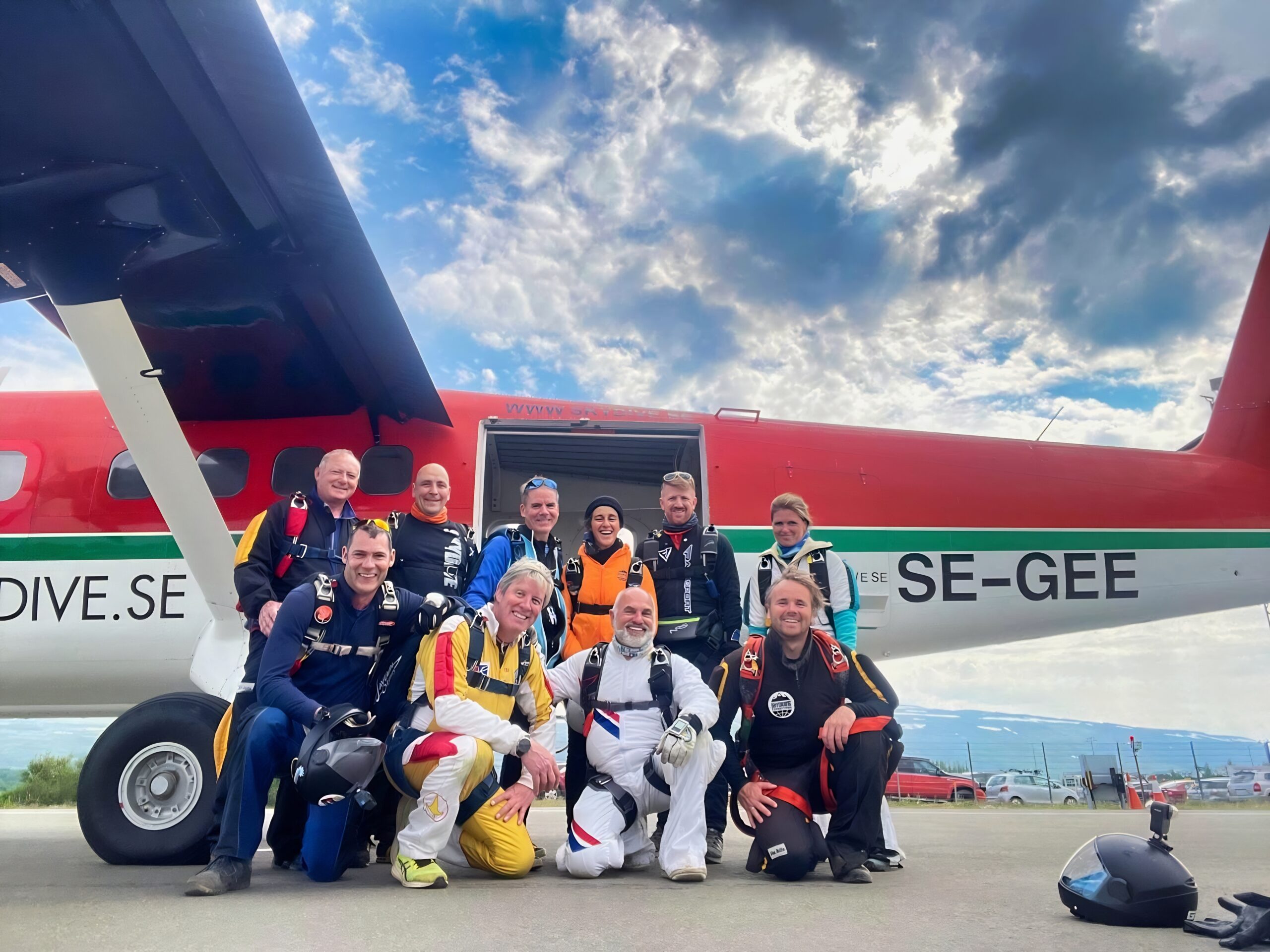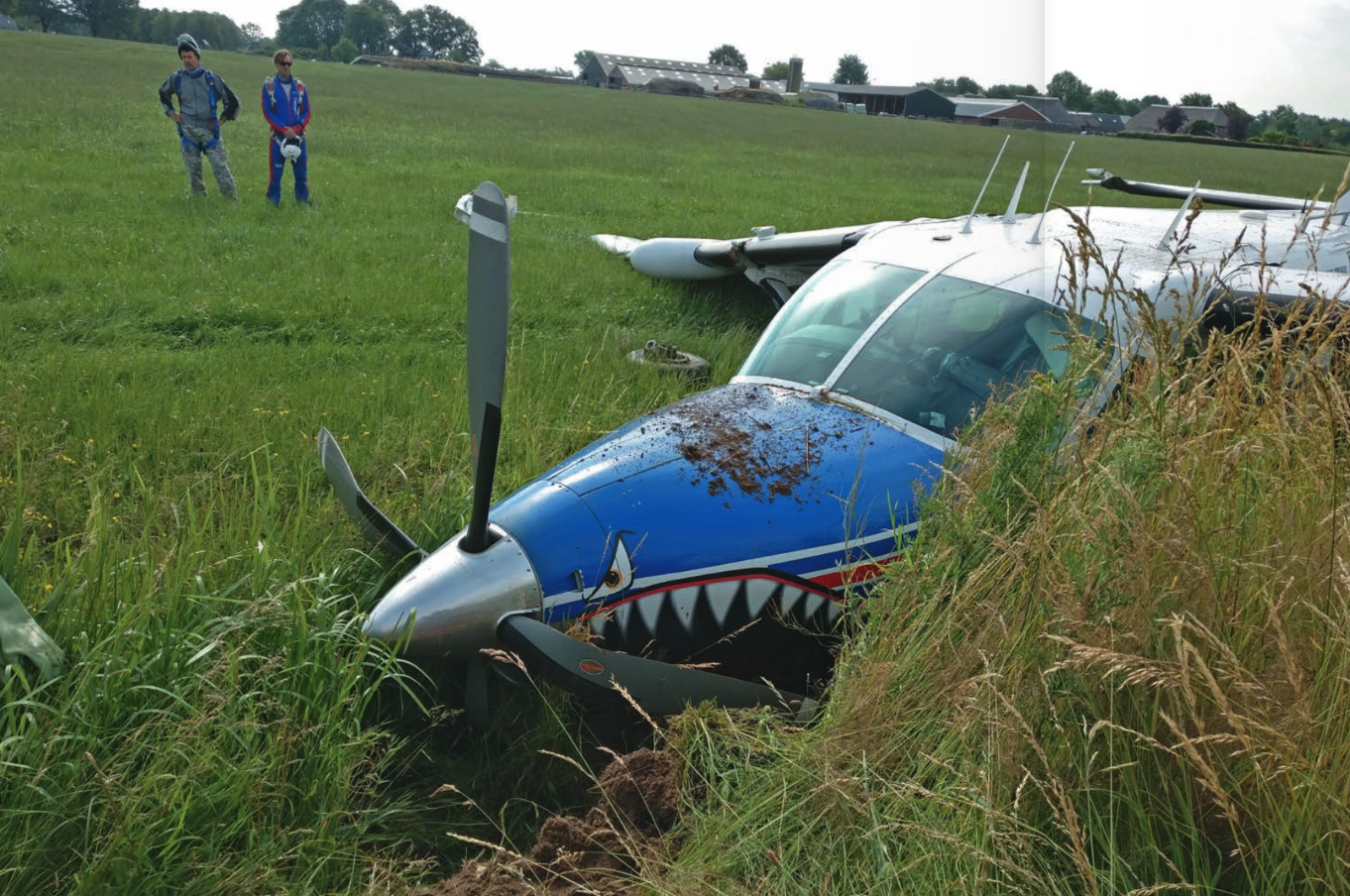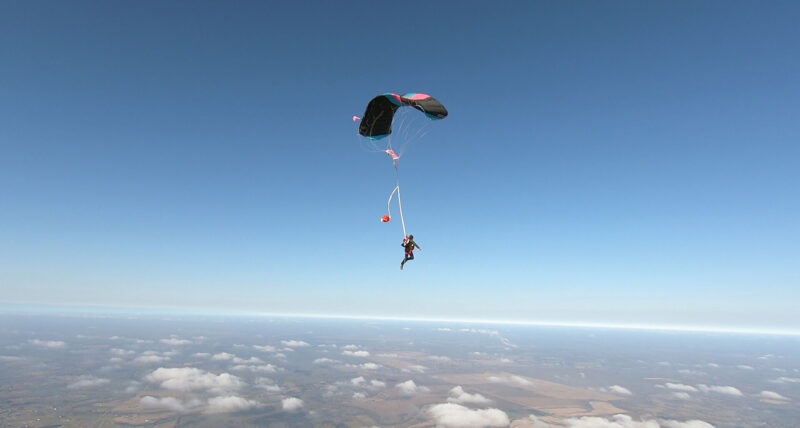Expedition Skydiving? You’re Invited.
By Arne Aarhus
So there Peter Cuthbert was, making his way slowly along in a passport control queue, surrounded by harried, holiday-bound families scrolling phones and pushing luggage. It’s not an entirely unfamiliar scene for him: he travels quite a bit. He, however, was a decidedly unfamiliar sight to most of the surrounding onlookers. He was, after all, wearing a skydiving rig – and a full-face helmet was perched, mushroom-style, atop his head.
As it turns out, you earn quite a few side-eyes when you venture off the dropzone thus attired. Peter was definitely catching his share.
He was not, however, alone in being under the scrutiny of the “muggles”. The rest of the load was queued right up along with him, all quietly mulling the briefing for the jump ahead. They’d be descending into the terrain five kilometres or so from a Faroe Islands airfield, next to a farming village where they’d probably be the most interesting thing to happen all summer.
For plenty of skydivers, the joy of skydiving comes down to a single, familiar pin on the map.
These skydivers tend to confine their enjoyment of the sport to the same airfield, meet up with the friends they’ve made there and, over time, execute gradually more advanced skydives over the local dropzone.

For some other jumpers, a passport comes into play every once in a while: perhaps in search of novelty, perhaps in search of better weather, this skydiver packs a bag and hoofs it over to another country or two.
The third kind of skydiver? They’re a special breed. This kind of skydiver doesn’t fuss over the number of jumps they make per day – or per year, for that matter. They’re less interested in counting points than passport stamps. This type loves to explore via skydiving: using the sport as a means of turning up the volume of their experience. They like seeing the spectacular local sights, just like anybody else; however, they prefer to see them framed in the little window of a Twin Otter.
This kind of jumper gets really excited about the idea of doing a 2,000km circle around, say, Iceland. They thrill to the idea of skydiving into a volcano by the light of the midnight sun; doing a scenic flight over an enormous waterfall, then shuffling out the door and landing right next to it; camping in the wilderness one night, checking into a luxury hotel the next; being conveyed by monster truck to the airstrip, where they load up to land next to a hot spring and trade their rigs for swimming costumes.
British skydivers are legendarily adventuresome folk. It’s not surprising, then, that so many expedition skydivers jump with British passports zipped into their jumpsuit pockets. My team at Expedition Skydiving, for instance, had seven British skydivers join us for the Circle of Iceland tour in 2022, and four for the Five Nations jumps in 2023.

MY LIFE, THE EXPEDITION
Hi. I’m Arne Aarhus. I’m lucky – and stubborn – enough to have done several interesting things in the business world as I have made my way along my personal path. I have the kind of personality that likes to get things done. These days, one of the things I’m doing is running Skydiving Expeditions: my labour of love. From my perspective, there is no better way of combining my two keenest interests: seeing the world and skydiving.
People who cannot skydive have to settle with a cruise ship, or a bus, but this is slow, and nowhere close to the same intensity of adventure. Even for those who do skydive – sure, you can travel to a different dropzone, in a different country, but at the end of the day you are still landing on the same spot every time. A skydiving expedition means that every skydive delivers a totally unique, memorable experience. That’s what I love most about the sport, and I do what I do in order to share that.
I have a big soft spot in my heart for Iceland. (My mother is Icelandic.) Because of this, I’ve been leading Circle of Iceland trips for many years. Then there was the Five Nations trip last year – the Tour de Norway – and my team and I are currently at the drawing board planning some other really special stuff: the Circle of Northern Europe; the Circle of Egypt; the Circle of Namibia; a Greenland expedition.

…BUT WHAT ABOUT THE RISKS?
Risk, in the context of a skydiving expedition – as with any descent sport – is always a very personal, very situational assessment.
If you’re used to doing 100 skydives at the same dropzone in one season, an expedition will certainly ask for more of your attention on every jump. Expect to give your full attention to thorough briefings, and know that you will be responsible for orienting yourself in the sky towards the intended landing area. You’ll need to be ready to adjust your altimeters and AAD to compensate for differentials in take-off and landing area altitudes.
You can also rest easy that, while the adventure is real, every jump of the trip will feature a large, tested landing area with several outs, and that you’ll have plenty of altitude to make your decisions.
If you are a safety-minded skydiver, the risks are not much greater than those of a “normal” dropzone skydive. That said: If you are a skydiver that does not know how to orient to a specified landing area and away from obstacles, expedition skydiving is simply not for you.
On our last expeditions, we saw skydivers with anywhere from 50 to 250 skydives executing every jump perfectly. However, those same loads bore multi-thousand-jump skydivers who landed in a way that would make a good instructor blush and stammer. I chalk this phenomenon up to complacency and hubris – both of which are very avoidable phenomena. (I suggest you avoid those two monsters everywhere, not just on an expedition skydive…but I digress.)
Peter Cuthbert, whom we met rocking his skydiving gear in passport control, had been trying to get into such a position for a while by the time he ended up in that queue.
Point of fact, he’d been talking to his skydiving buddy Mark McConnell for years about trying to complete a cross-national expedition.
“It’s just so difficult now,” he said, “to organise this kind of thing yourself. When I had the chance to do this Five Nations thing, I was sold.”
Peter and Mark set out from Edinburgh to Iceland on the same early-morning flight, landing in Reykjavik just in time to join the city in a highly festive celebration of the country’s National Day. Later that evening, they met up with the rest of the crew –”quite a wide variety of nationalities and people” – for the first briefing. The next morning, it began: Reykjavik to Egilsstadir.
“We took off from quite an overcast and rainy Reykjavik,” Peter recalls. “Once we were at altitude, it became quite clear – below us, we could see the mountains, the ice sheets, the glaciers…all very, very dramatic.”
“The air outside, while very clear, was heavy with ice crystals,” he continues. “We exited with a clear view of the ground below us. We were all open at around 6,000ft, soaking up the terrain and the sights roundabout us. Landing from that jump, next to a remote airstrip, was the moment the trip really began for me. We were all packing on the grass together, very, very happy.”
From there, the little load of expeditioners suited up and made their way across the Norwegian sea, bound for the Faroe Islands.
“As soon as we left the coast of Iceland, we went straight into cloud,” Peter remembers. “When we started to get closer to the Faroe Islands, the clouds miraculously started to break up. The pilot took us down to a couple hundred feet above the surface of the sea. We followed the coastline of the Faroes – all the high rocky cliffs and waterfalls – and we hugged the coastline all the way until we landed at the airstrip. It was spectacular. Very memorable.”
Mark McConnell agrees. Mark grew up with skydiving. (In 1977, he started to join his skydiving father on the dropzone instead of going to football matches.) In 1991, the elder McConnell did his own five nations skydiving trip – Scotland, England, Ireland, the Isle of Man and Wales – all in a day. McConnell junior didn’t join for that trip, but he’s thought about it ever since.
Fast forward 32 years.
At one of the recent Pharaohs boogies in Egypt, Mark overheard Ally Milne talking to another jumper about the Skydiving Expeditions trip. He leapt onto Facebook to whip up Peter’s participation and book the slots. Unsurprisingly, he loved it: from the heater in the Swedish Twin Otter (nicknamed Erick-Erick) to the jolly vibe of the group, which he smilingly reports to have gotten along “very well.”
“We knew that, at any point, weather could stop us,” he says. “But it never did. And any hiccups that delayed us along the way never turned into dramas. It was a great atmosphere from start to finish.”

THE ADVENTURE IN NUMBERS*
Total time:
30 hrs 50 mins
Total flying time:
1,469 total miles/2,120km
8 hrs
Reykjavik to Egilsstadir:
235 miles/379km
1.25 hrs
Egilsstadir to the Faroe Islands:
324 miles/521km
2.0 hrs
Faroe Islands to Sumburgh:
380 miles/366km
1.5 hrs
Shetland Islands to Bergen:
230 miles/370km
1:33 hrs
Bergen to Gothenburg:
300 miles/484km
1.75 hrs
*With thanks to Bill Welch (USA)
Arne Aarhus, born to a Norwegian father and an Icelandic mother, grew up in Germany and started skydiving in 1992. He started BASE jumping in 1995 and founded Icehopp, now known as Skydiving Expeditions, in 2021. To ask about joining an upcoming expedition, visit skydivingexpeditions.com
Want to find more stories like this? Download the official Skydive the Mag app on either apple or android. Don’t want to download? Don’t worry. You can read the online version here.





